![]()
 |
The Cast |
The Story
Few people have actually ever seen a 1948 Tucker Torpedo. This is perfectly understandable because only fifty of the revolutionary cars were ever built. Of
these, however, forty-eight are still on the
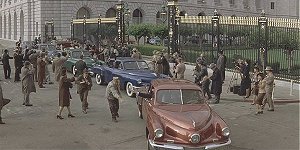 road. Even today, the Tucker Torpedo boldly announces that it was once a car ahead of its time. It was the most aerodynamic automobile of its day. Thanks to its “slippery” design and six-cylinder, 166-horsepower fuel-injected Franklin helicopter engine, the Torpedo could accelerate from zero to sixty miles an hour in under 6 seconds, travel at speeds well over 100 miles an hour, and deliver more than twenty miles a gallon. It had excellent stopping power due to its four-wheel disc brakes, and the rigid frame and the absence of a transmission shaft made for a roomy passenger compartment that also sported excellent crash-proof characteristics. The dash was padded, seat belts were provided in both the front and rear seats, and the safety-glass windshield was designed to pop out when struck from within. “The first completely new car in fifty years” lived up to the claim, from its rear-mounted
aluminum engine and low, sloping roofline to the peculiar “Cyclops Eye”: the third front headlight that turned with the wheels. Tom McCahill, a veteran auto reviewer, called the ‘48 Tucker “one of the greatest automobiles ever built.”
road. Even today, the Tucker Torpedo boldly announces that it was once a car ahead of its time. It was the most aerodynamic automobile of its day. Thanks to its “slippery” design and six-cylinder, 166-horsepower fuel-injected Franklin helicopter engine, the Torpedo could accelerate from zero to sixty miles an hour in under 6 seconds, travel at speeds well over 100 miles an hour, and deliver more than twenty miles a gallon. It had excellent stopping power due to its four-wheel disc brakes, and the rigid frame and the absence of a transmission shaft made for a roomy passenger compartment that also sported excellent crash-proof characteristics. The dash was padded, seat belts were provided in both the front and rear seats, and the safety-glass windshield was designed to pop out when struck from within. “The first completely new car in fifty years” lived up to the claim, from its rear-mounted
aluminum engine and low, sloping roofline to the peculiar “Cyclops Eye”: the third front headlight that turned with the wheels. Tom McCahill, a veteran auto reviewer, called the ‘48 Tucker “one of the greatest automobiles ever built.”
And all this was promised for $1500, at a time when the cheapest car made in America was the $1320 Ford Sedan.
A business venture with a product as clearly superior and advanced as the Tucker Torpedo seems unlikely to fail--but it did. And there are many historians who feel that there is more than enough evidence to support the contention that Tucker’s failure was the result of a conspiracy by Chrysler, Ford, and General Motors to stop production of the Tucker Torpedo, shut down the Tucker Corporation, and destroy Preston Tucker’s dream.
Preston Tucker was an innovator and inventor. Profit was undoubtedly a motivation for Tucker, but his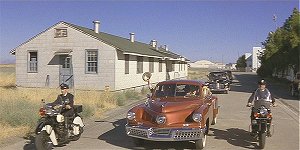 stated goal in life was to build “something completely new and different.” After a decade of seeing his inventions incorporated into other companies’ planes and automobiles, he started the Tucker Aviation Corporation in 1937. The 117-mph combat vehicle he built and demonstrated for the Army was impressive, but of no practical use. However, the vehicle’s innovative gun turret design did interest the military, and, by the time World War II broke out in 1941, every bomber built in America used the plexiglass Tucker turret.
stated goal in life was to build “something completely new and different.” After a decade of seeing his inventions incorporated into other companies’ planes and automobiles, he started the Tucker Aviation Corporation in 1937. The 117-mph combat vehicle he built and demonstrated for the Army was impressive, but of no practical use. However, the vehicle’s innovative gun turret design did interest the military, and, by the time World War II broke out in 1941, every bomber built in America used the plexiglass Tucker turret.
At the end of the war, the American public, denied new automobiles since 1941, was waiting impatiently for someone to develop a better car. Coupled with this was President Franklin Roosevelt’s desire to see innovative entrepreneurs succeed in the American marketplace. Roosevelt had promised the American public and the AFL-CIO in 1942 that the monopolistic practices of the Big Three automakers would be halted, and he had guaranteed legal action if independent businessmen were not given a fair chance in the market. As part of this policy, all surplus war supply factories were to be sold at the end of the war to qualified independent buyers. Tucker saw an opportunity to make his dream of building something completely new and different come true.
Tucker was awarded the Dodge
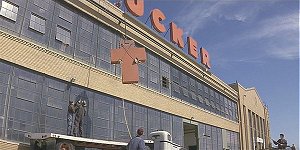 B-29 factory in Chicago in 1946. Encompassing 475 acres and worth an estimated $170 million, it was the largest production facility in the world. In addition to buying the world’s
biggest manufacturing plant, Tucker also hired some of the best professionals in the automotive business:
Eddie Offutt was one of the best and brightest engineers in America, Alex
Tremulis, a young designer just out of the Air Force, was hired to head the design department, and
Cliff Knoble, fresh from Hollywood, became the company’s advertising manager.
Robert Bennington (this character is a composite of Fred Rockelman and
Harry Toulmin), an experienced operations manager and Vice-president of Ford, was hired as the Tucker Corporation’s President and Chief Executive Officer.
B-29 factory in Chicago in 1946. Encompassing 475 acres and worth an estimated $170 million, it was the largest production facility in the world. In addition to buying the world’s
biggest manufacturing plant, Tucker also hired some of the best professionals in the automotive business:
Eddie Offutt was one of the best and brightest engineers in America, Alex
Tremulis, a young designer just out of the Air Force, was hired to head the design department, and
Cliff Knoble, fresh from Hollywood, became the company’s advertising manager.
Robert Bennington (this character is a composite of Fred Rockelman and
Harry Toulmin), an experienced operations manager and Vice-president of Ford, was hired as the Tucker Corporation’s President and Chief Executive Officer.
Tucker inspired his employees to work as he did--to the limit. He was described by Knoble as a man “who could not only sell refrigerators to Eskimos, but also have them liking the refrigerators after the purchase.” What Tucker lacked in polish, he made up for in enthusiasm and positive thinking. He was as stubborn as he was enthusiastic, however, and he was absolutely determined to build the finest car in the world.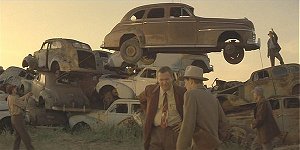
The “Tin Goose,” Tucker’s hand-built prototype, went from sketch pad to reality in less than 100 days. Hastily built from scraps and salvage, the Tin Goose had problems: it lacked the promised disc brakes, fuel injection, and turnable front headlight; 24 truck batteries were required to jump-start it; and it had no workable reverse gear. In spite of these flaws, the Tin Goose made its official debut before an admiring throng of 5,000 at the Tucker plant in 1947. Orders for the car soon topped 150,000.
But even as the Tucker Torpedo became a national sensation, powerful forces were mobilizing in Detroit that would ultimately destroy Tucker’s dream. Roosevelt died before he could fulfill his promise to open up the automobile market, and the Big Three began to swallow up every manufacturing plant and small automobile company in the country. Tucker found himself blocked from access to raw materials when Chrysler and GM threatened Tucker’s suppliers, telling companies that they would place their business in jeopardy if they sold to Tucker. Ford even tried to buy out Tucker; although it isn’t clear whether it intended to use his designs or simply take them off the market.
To make matters worse, Tucker never had enough money.
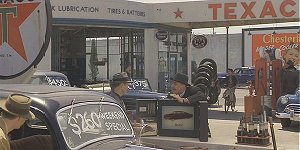 Although he managed to raise about $28 million from selling shares and dealer franchises, it was not nearly enough for the size operation he was attempting to build. He needed another $20 million, which the Tucker Corporation’s Chief Financial Officer,
Abe Karatz, intended to raise from the sale of company stock on the open market. The newly-formed Securities and Exchange Commission, on the orders of Director
Harry MacDonald, quickly launched an investigation which found 15 irregularities leading to charges of mail fraud, violations of SEC regulations, and conspiracy to defraud the public. The stock issue was stopped before it actually began. Tucker was told this investigation would last ten days; it lasted over six months.
Although he managed to raise about $28 million from selling shares and dealer franchises, it was not nearly enough for the size operation he was attempting to build. He needed another $20 million, which the Tucker Corporation’s Chief Financial Officer,
Abe Karatz, intended to raise from the sale of company stock on the open market. The newly-formed Securities and Exchange Commission, on the orders of Director
Harry MacDonald, quickly launched an investigation which found 15 irregularities leading to charges of mail fraud, violations of SEC regulations, and conspiracy to defraud the public. The stock issue was stopped before it actually began. Tucker was told this investigation would last ten days; it lasted over six months.
Then, while suppliers disappeared and the SEC held up the stock issue, Tucker’s possession of the production facility was threatened. Michigan Senator
Homer Ferguson, the head of the Surplus Property Committee, claimed Tucker wasn’t capable of making the payments on the plant, and threatened to evict him if he didn’t immediately produce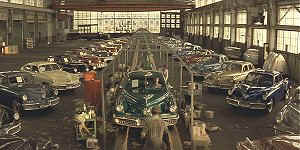 sufficient funds to cover the purchase. It was obvious that Tucker couldn’t possibly produce such funds until he sold his stock, and so the Committee ordered Tucker to vacate the plant.
sufficient funds to cover the purchase. It was obvious that Tucker couldn’t possibly produce such funds until he sold his stock, and so the Committee ordered Tucker to vacate the plant.
The situation became even more complex when Robert Bennington resigned, complaining of Tucker’s “fraudulent criminal behavior.” Bennington later testified against Tucker at the SEC trial, and-- coincidentally--was named President of the Plymouth Division of the Ford Motor Company the following year.
The final blow came when Washington columnist and radio personality Drew Pearson announced that Tucker CFO Abe Karatz had a criminal record, and that the Justice Department was preparing an investigation into the corporation’s finances. Overnight, Tucker stock plummeted; investors lost over $10 million. Operations ground to a halt. In August, a mere five weeks before the factory would have gone into full production, the company was shut down completely by the Federal Marshall’s office. Only thirty-eight cars had been built.
Tucker’s trial began in October, 1949. He faced 31 counts of fraud and conspiracy which could have brought him 155 years in prison with fines up to $160 million.
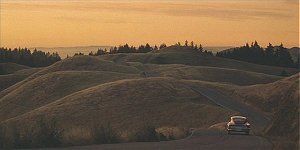 After four months, and an impassioned plea in his own defense, Preston Tucker was acquitted on all counts. Tucker won the battle, but his opponents won the war. The Tucker Corporation went into receivership, and all assets of the company were sold for eighteen cents on the dollar, including the fifty-one cars he had now completed.
After four months, and an impassioned plea in his own defense, Preston Tucker was acquitted on all counts. Tucker won the battle, but his opponents won the war. The Tucker Corporation went into receivership, and all assets of the company were sold for eighteen cents on the dollar, including the fifty-one cars he had now completed.
In spite of the destruction of his company, Preston Tucker went on to other successful projects including a pneumatic pump which was used in oil production, and the freon cooling system presently used in refrigerators. If Preston Tucker was guilty of anything, it was of being a bit naive. Despite a lifetime of entrepreneurship, his previous experiences weren’t enough to prepare him for the biggest business venture of his life, or the resistance of an oligopolistic market.
|
ASSIGNMENT
|
| The Tucker Car: Did the Big Three Do It In? | An Open Letter From Preston Tucker | John DeLorean |